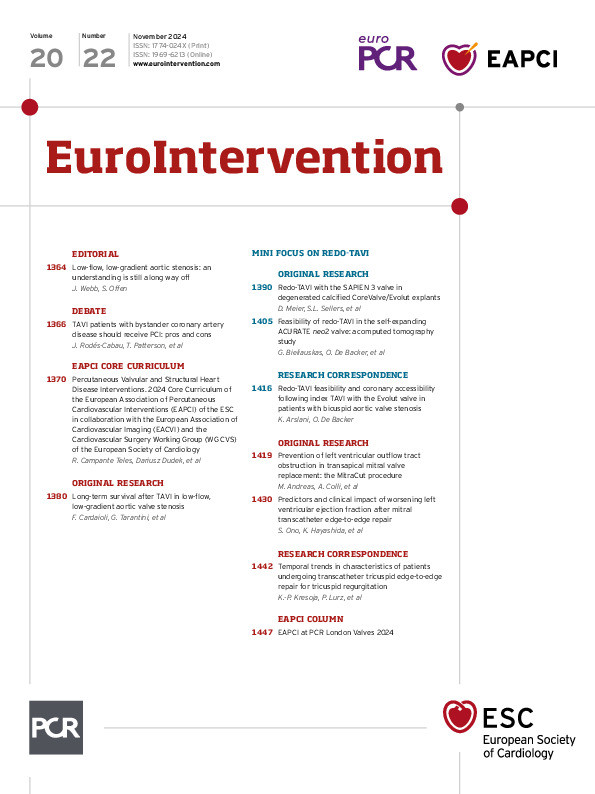Low-gradient (LG) aortic stenosis (AS) is estimated to account for at least one-third of all presentations in patients with suspected severe AS. Even though frequently encountered in clinical practice, patients with LG-AS are less likely to be referred for aortic valve replacement (AVR) compared to those with high-gradient (HG) AS, despite evidence to suggest a survival benefit with AVR over conservative management1. At least part of this therapeutic inertia is no doubt secondary to the ongoing diagnostic challenge associated with the correct adjudication of stenosis severity in patients presenting with discordant markers of AS severity on initial transthoracic echocardiography. Current society guidelines advocate a stepwise integrated approach for the diagnosis of LG-AS, utilising dobutamine stress echocardiography (DSE) and/or computed tomography calcium score, in patients with an aortic valve area <1 cm2 and a mean gradient <40 mmHg2. These additional diagnostic modalities are intended to classify patients into 1 of 2 dominant patterns in LG-AS: classical low-flow, LG-AS (cLFLG-AS), in patients with a depressed left ventricular ejection fraction (LVEF; <50%), and paradoxical LFLG-AS (pLFLG-AS), in those with a normal LVEF but a low-flow state, as suggested by a reduction in the stroke volume index (<35 mL/m2). However, DSE may be non-diagnostic in approximately 55% of patients with cLFLG-AS3, and the utility of aortic valve calcium scoring in LG-AS has also recently been called into question4. It is therefore unsurprising that this patient population remains one of the more complex entities in valvular heart disease and, consequently, are often overlooked for appropriate intervention.
In this issue of EuroIntervention, Cardaioli et al5 report on the long-term outcomes of patients with LG-AS undergoing transcatheter aortic valve implantation (TAVI). The authors performed a retrospective analysis of 574 consecutive patients at their institution, including 91 (15%) with pLFLG-AS, 64 (11%) with cLFLG-AS and 419 (73%) with HG-AS (>40 mmHg) who were followed for up to 12.3 years (median 4.8 years). The main findings of the study were as follows: (1) all-cause mortality was higher in patients with cLFLG-AS compared to both pLFLG-AS and HG-AS, which was most apparent in the first year following TAVI; (2) after adjustment for baseline covariates, including LVEF, the authors found no impact of flow status on long-term survival; and (3) LVEF improved by >10% in nearly two-thirds of patients with cLFLG-AS, and this was associated with improved survival. Cardaioli et al are to be commended for contributing important longer-term follow-up data on this still poorly understood group of patients with LG-AS.
Consistent with previous studies and meta-analyses167, a low-flow state was a powerful predictor of outcome, and patients with cLFLG-AS appeared to fare the worst (1-year Kaplan-Meier estimates: 75% for cLFLG-AS, 89% for pLFLG-AS, and 88% for HG-AS; p=0.009). Following adjustments for possible baseline confounders (including LVEF), however, the authors failed to find any significant differences in longer-term outcomes in patients with cLFLG-AS and HG-AS, leading them to surmise that it was the patients’ comorbidities which had a greater impact on prognosis than the low-flow state itself. Arguably, this finding is not novel, with the comorbid nature of cLFLG-AS patients consistent with similar larger cohorts6, and has been previously attributed to their poorer rates of survival following TAVI8. The degree of left ventricular (LV) impairment has also been shown to be a poor predictor of outcome in these patients7. The findings from the current study therefore reiterate that careful patient selection for TAVI in patients with LG-AS is paramount, and likely more important than haemodynamics alone.
A degree of LV improvement following TAVI was also seen in nearly two-thirds of the current cohort with cLFLG-AS and was associated with an improvement in outcomes. This seems important and has frequently been reported in LG-AS (and HG-AS) cohorts678. Unfortunately, the authors did not have access to preprocedural DSE for the current cohort, with which they might have been able to compare the degree of contractile reserve, if any, with LV recovery. Previous studies have not, however, supported contractile reserve as a useful indicator of LV improvement over time9. Therefore the question remains as to how we predict those with the best likelihood for LVEF recovery and, thereby, clinical outcomes post-TAVI.
Patients with pLFLG-AS, on the other hand, have a normal LVEF and an impaired stroke volume due to a small LV cavity size and concentric remodelling leading to an intrinsic impairment in myocardial function. Contrary to the data presented in the current study, previous investigators have found higher rates of cardiovascular comorbidities also in patients with pLFLG-AS6, raising the possibility that LG-AS may exist on a continuum, with cLFLG-AS an expression of a later stage of the same disease. Studies have described a poorer prognosis in pLFLG-AS compared to HG-AS, which is in contrast to the similar outcomes on unadjusted models presented in the current study. With only 64 patients included in this cohort, lack of an adequate sample size may contribute to this discrepancy.
In summary, the authors report on a topical group of patients with LG-AS, who remain underdiagnosed and undertreated in the cardiology community. They should be congratulated for contributing to the body of evidence that post-TAVI survival of these patients is comparable to those with HG-AS and is sustained in longer-term follow-up. Many of the findings presented, however, corroborate previous literature rather than move the needle forward to any great degree in our understanding of patients with LG-AS. Furthermore, the small patient cohort, particularly the number followed beyond 5 years, leaves significant unanswered questions regarding long-term outcomes of patients with LG-AS. Further studies are required to determine which patients with LG-AS, and at what timepoint, are most likely to benefit from valve replacement.
Conflict of interest statement
J. Webb reports consulting fees from Edwards Lifesciences. S. Offen has no conflicts of interest to declare.

